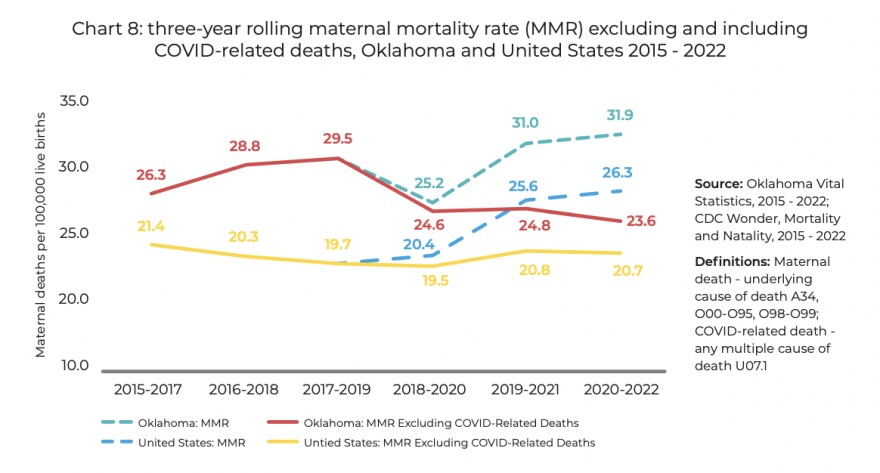Oklahoma’s maternal mortality rate increased slightly, according to an annual state report. The uptick was consistent with elevated rates nationally that are linked, in part, to COVID-related deaths.
Data from Oklahoma Vital Statistics outlines an increase in maternal deaths from 31 per 100,000 live births during the 2019-2021 reporting period to 31.9 per 100,000 from 2020-2022. The national rate was 26.3 per 100,000 during that time.

Oklahoma’s definition of maternal death includes the death of a woman while pregnant or within 42 days after a pregnancy’s termination “from any cause related to or aggravated by the pregnancy or its management.” The definition excludes accidental or incidental causes.
That rate varies significantly by race in Oklahoma. White women had the lowest maternal mortality rate at 22.8 per 100,000 live births, while Black women had 70 per 100,000. In 2022, the maternal mortality rate for Black women was 49.5 per 100,000 nationally.

The report, which was issued by the Oklahoma State Department of Health, notes that three-year maternal mortality rates remain elevated locally and nationally because of COVID-19-related deaths. Those accounted for a quarter of Oklahoma’s maternal deaths compared to one-fifth nationally.
Excluding COVID-related deaths, the nation’s maternal mortality rate decreased by .5% and fell by 4.8% in Oklahoma, according to the report.
Oklahoma also has a process to identify and explore medical facts surrounding the state’s maternal deaths through its Maternal Mortality Review Committee. The group has statutory authority to review pregnancy-associated deaths and obtain documents from them, like medical examiner reports, and medical and law enforcement records.
But the report notes there are limitations to the data it can gather on Indigenous Oklahomans, as state statute does not necessarily apply to tribal organizations and providers because of Indigenous data sovereignty.

The committee has reviewed 80 deaths occurring during pregnancy or within one year of a pregnancy’s termination from 2017-2021. It found that 52.5% were pregnancy-related, which is “a death caused by a pregnancy complication, a chain of events initiated by pregnancy, or the aggravation of an unrelated condition by the physiologic effects of pregnancy.”
Nearly 80% of these deaths were deemed preventable.
Contributing factors included substance use disorders, patients' adherence to recommendations like prenatal care and being vaccinated for the flu or COVID-19, chronic conditions and delays in care. The top causes of pregnancy-related deaths were hemorrhages, infections and cardiac conditions.
According to the Oklahoma Behavioral Risk Factor Surveillance System, chronic conditions and reduced access to care are prevalent among women of reproductive age. State data reported among women ages 18 through 44 in 2022 found:
- 16.8% reported their health status as fair or poor
- 23.3% felt that in the past year, a doctor's visit was too costly to attend
- 4.7% of women reported ever receiving a diabetes diagnosis
- 3.3% reported gestational diabetes
- 70.1% with known BMI were considered overweight or obese
- 15.2% were current smokers
Over half of Oklahoma’s 77 counties are also maternity care deserts, which are predominantly rural areas without obstetric care and providers.
To combat maternal morbidity and mortality, the committee offered a series of recommendations:
- Addressing and reducing the prevalence of chronic conditions which can increase risk
- Increase the adoption of guidelines for pregnancy and postpartum care
- Addressing gaps in provider knowledge on complications
- Improve the quality of prenatal and postpartum care
- Advocate for legislation to reduce maternal deaths
A new law aiming to increase the efficiency of the Maternal Mortality Review Committee and the data available to it recently went into effect. House Bill 2152 requires hospitals to make a reasonable effort to report all maternal deaths to the Chief Medical Examiner within 72 hours.
“With better data, the (Oklahoma Maternal Mortality Review Committee) can help us implement better strategies to reduce maternal deaths in Oklahoma,” Sen. Jo Anna Dossett (D-Tulsa) said in a press release.
A once-optional practice is now mandatory under HB 2152 — reported deaths must be investigated. The results from those reports will be sent to the Oklahoma Maternal Mortality Review Committee.
The law also decreases the membership of the committee from 25 to 11.
StateImpact Oklahoma is a partnership of Oklahoma’s public radio stations which relies on contributions from readers and listeners to fulfill its mission of public service to Oklahoma and beyond. Donate online.







